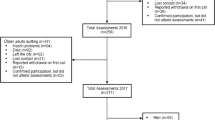Abstract
OBJECTIVE: To compare levels of physical function, across levels of body mass index (BMI), among middle- to older-aged women.
DESIGN: Cross-sectional study. Physical function, body weight and other covariates were measured in 1992.
SUBJECTS: 56 510 women aged 45–71 y, free of cardiovascular disease and cancer, participating in the Nurses’ Health Study.
MAIN OUTCOME MEASURES: The four physical function scores on the Medical Outcomes Study (MOS) Short Form-36 (SF36) Health Survey: physical functioning, vitality, bodily pain and role limitations.
RESULTS: After adjusting for age, race, smoking status, menopausal status, physical activity and alcohol consumption, there was a significant dose-response gradient between increasing levels of BMI in 1992 and reduced function. For example, women with a BMI between 30–34.9 kg/m2 averaged: 9.0 point lower physical functioning score (95% Confidence interval (CI) −9.5, −8.5), 5.6 point lower vitality score (95% CI: −6.1, −5.1), and 7.0 point lower freedom from pain score (95% CI: −7.6, −6.4). These declines represent an approximate 10% loss of function compared to the reference category of women with BMIs ranging from 22.0–23.9 kg/m2. For the same BMI comparison, heavier women were at 66% increased risk of limitations in ability to work or perform other roles (RR=1.66; 95% odds ratio (OR) CI: 1.56, 1.76). These findings were replicated when the sample was restricted to women who had maintained their BMI over a ten year period.
CONCLUSIONS: In addition to increasing risk of chronic health conditions, greater adiposity is associated with lower every day physical functioning, such as climbing stairs or other moderate activities, as well as lower feelings of well-being and greater burden of pain.
This is a preview of subscription content, access via your institution
Access options
Subscribe to this journal
Receive 12 print issues and online access
$259.00 per year
only $21.58 per issue
Buy this article
- Purchase on Springer Link
- Instant access to full article PDF
Prices may be subject to local taxes which are calculated during checkout
Similar content being viewed by others
Author information
Authors and Affiliations
Rights and permissions
About this article
Cite this article
Coakley, E., Kawachi, I., Manson, J. et al. Lower levels of physical functioning are associated with higher body weight among middle-aged and older women. Int J Obes 22, 958–965 (1998). https://doi.org/10.1038/sj.ijo.0800698
Received:
Revised:
Accepted:
Published:
Issue Date:
DOI: https://doi.org/10.1038/sj.ijo.0800698
Keywords
This article is cited by
-
Factors associated with health-related quality of life in women using path analyses: mediation effect of the adiposity traits
BMC Women's Health (2021)
-
Are BMI and inflammatory markers independently associated with physical fatigability in old age?
International Journal of Obesity (2019)
-
Being slightly overweight is associated with a better quality of life in breast cancer survivors
Scientific Reports (2018)
-
Trajectories of mood and stress and relationships with protective factors during the transition to menopause: results using latent class growth modeling in a Canadian cohort
Archives of Women's Mental Health (2017)
-
Body-Mass-Index
Der Diabetologe (2015)



